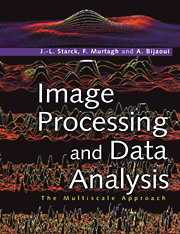Book contents
- Frontmatter
- Contents
- Preface
- 1 The wavelet transform
- 2 Multiresolution support and filtering
- 3 Deconvolution
- 4 1D signals and Euclidean data analysis
- 5 Geometric registration
- 6 Disparity analysis in remote sensing
- 7 Image compression
- 8 Object detection and point clustering
- 9 Multiscale vision models
- APPENDIX A Variance stabilization
- APPENDIX B Software information
- APPENDIX C Acronyms
- Bibliography
- Index
1 - The wavelet transform
Published online by Cambridge University Press: 30 October 2009
- Frontmatter
- Contents
- Preface
- 1 The wavelet transform
- 2 Multiresolution support and filtering
- 3 Deconvolution
- 4 1D signals and Euclidean data analysis
- 5 Geometric registration
- 6 Disparity analysis in remote sensing
- 7 Image compression
- 8 Object detection and point clustering
- 9 Multiscale vision models
- APPENDIX A Variance stabilization
- APPENDIX B Software information
- APPENDIX C Acronyms
- Bibliography
- Index
Summary
Multiscale methods
A range of very different ideas have been used to formulate the human ability to view and comprehend phenomena on different scales. Wavelet and other multiscale transforms are treated in this book. Just a few alternative approaches are surveyed in this section. In this section also, various terms are introduced in passing, which will reappear many times in later chapters.
Data classification may be carried out using hierarchical classification (Murtagh, 1985). A sequence of agglomerative steps is used, merging data objects into a new cluster at each step. There is a fixed number of total operations in this case. Such an approach is bottom-up, starting with the set of data objects, considered independently. Spatial and other constraints may be incorporated, to provide segmentation or regionalization methods. This approach is combinatorial since neither continuous data values, nor stochasticity, are presupposed. For alternative combinatorial methods, see Breiman et al. (1984) and Preparata and Shamos (1985). For image data, split-and-merge approaches are introduced in Schalkoff (1989).
Let us now consider two-dimensional (or other) images. An image represents an important class of data structures. Data objects may be taken as pixels, but it is more meaningful for image interpretation if we try, in some appropriate way, to take regions of the image as the data objects. Such regions may be approximate. One approach is to recursively divide the image into smaller regions. Such regions may be square or rectangular, to facilitate general implementation.
Information
- Type
- Chapter
- Information
- Image Processing and Data AnalysisThe Multiscale Approach, pp. 1 - 45Publisher: Cambridge University PressPrint publication year: 1998
Accessibility standard: Unknown
Why this information is here
This section outlines the accessibility features of this content - including support for screen readers, full keyboard navigation and high-contrast display options. This may not be relevant for you.Accessibility Information
- 2
- Cited by
